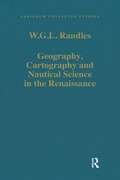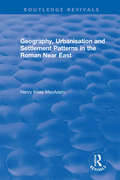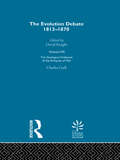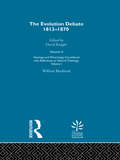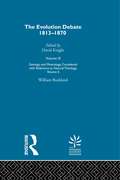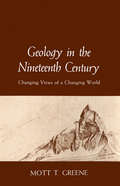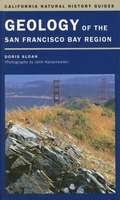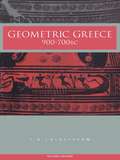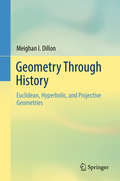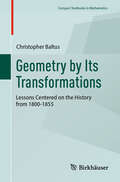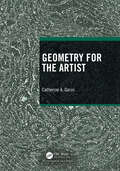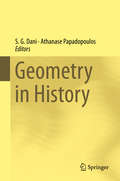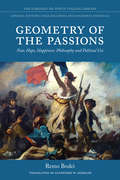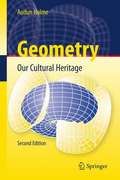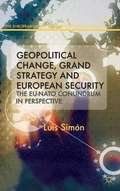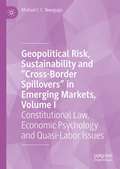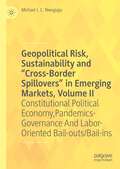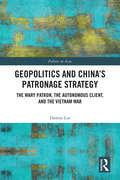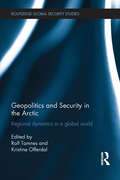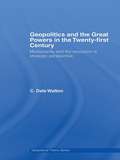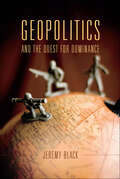- Table View
- List View
Geography, Cartography and Nautical Science in the Renaissance: The Impact of the Great Discoveries (Variorum Collected Studies)
by W.G.L. RandlesThe transformation of the medieval European image of the world in the period following the Great Discoveries of the 15th and 16th centuries is the subject of this volume. The first studies deal specifically with the emergence of the concept of the terraqueous globe. In the following pieces Dr Randles looks at the advances in Portuguese navigation and cartography that helped sailors overcome the obstacles to the circumnavigation of Africa and the crossing of the Atlantic, and at the impact of the Discoveries on European culture and science. Other articles are concerned with Portuguese naval artillery, and with attempts to classify the indigenous societies of the newly-discovered lands and to map the interior of Africa.
Geography, Religion, Gods, and Saints in the Eastern Mediterranean (Studies in the History of the Ancient Near East)
by Erica FergGeography, Religion, Gods, and Saints in the Eastern Mediterranean explores the influence of geography on religion and highlights a largely unknown story of religious history in the Eastern Mediterranean. In the Levant, agricultural communities of Jews, Christians, and Muslims jointly venerated and largely shared three important saints or holy figures: Jewish Elijah, Christian St. George, and Muslim al-Khiḍr. These figures share ‘peculiar’ characteristics, such as associations with rain, greenness, fertility, and storms. Only in the Eastern Mediterranean are Elijah, St. George, and al-Khiḍr shared between religious communities, or characterized by these same agricultural attributes – attributes that also were shared by regional religious figures from earlier time periods, such as the ancient Near Eastern Storm-god Baal-Hadad, and Levantine Zeus. This book tells the story of how that came to be, and suggests that the figures share specific characteristics, over a very long period of time, because these motifs were shaped by the geography of the region. Ultimately, this book suggests that regional geography has influenced regional religion; that Judaism, Christianity, and Islam are not, historically or textually speaking, separate religious traditions (even if Jews, Christians, and Muslims are members of distinct religious communities); and that shared religious practices between members of these and other local religious communities are not unusual. Instead, shared practices arose out of a common geographical environment and an interconnected religious heritage, and are a natural historical feature of religion in the Eastern Mediterranean. This volume will be of interest to students of ancient Near Eastern religions, Judaism, Christianity, Islam, sainthood, agricultural communities in the ancient Near East, Middle Eastern religious and cultural history, and the relationships between geography and religion.
Geography, Technology and Instruments of Exploration (Studies In Historical Geography Ser.)
by Fraser MacDonald Charles W.J. WithersFocusing on aspects of the functioning of technology, and by looking at instruments and at instrumental performance, this book addresses the epistemological questions arising from examining the technological bases to geographical exploration and knowledge claims. Questions of geography and exploration and technology are addressed in historical and contemporary context and in different geographical locations and intellectual cultures. The collection brings together scholars in the history of geographical exploration, historians of science, historians of technology and, importantly, experts with curatorial responsibilities for, and museological expertise in, major instrument collections. Ranging in their focus from studies of astronomical practice to seismography, meteorological instruments and rockets, from radar to the hand-held barometer, the chapters of this book examine the ways in which instruments and questions of technology - too often overlooked hitherto - offer insight into the connections between geography and exploration.
Geography, Urbanisation and Settlement Patterns in the Roman Near East (Routledge Revivals)
by Henry Innes MacAdamThis title was first published in 2002: This volume focuses on the Roman provinces of Syria and Arabia, above all the lands now within Lebanon, Syria and Jordan. The first articles look at questions of geography, cartography and toponymy, particularly in Strabo, Pliny and Ptolemy. The following sections are concerned with settlement patterns and urban development in the region. In the Roman and early Byzantine periods, the inland areas underwent a gradual transformation, from a semi-sedentary, lightly populated and predominantly rural region, to one of large cities and a network of prosperous, socially sophisticated villages, linked by a network of roads. That change is documented by a wealth of epigraphy from both the urban communities and their outlying settlements (the subject of several articles). By the 4th century, too, Christianity had become the dominant religion and remained such until the arrival of Islam.
Geological Evidence of the Antiquity of Man, 1863: With Remarks On Theories Of The Origin Of Species By Variation
by Charles LyellCharles Lyell's argument in this classic volume is that the processes of nature are slow and uniform, and that the Earth is in consequence hundreds of millions of years old. This work includes his prediction that if our nearest relatives are great apes, then the places to look for human fossils will be central Africa and Indonesia.
Geology & Mineralogy, Considered with Reference to Natural Theology, Volume I, 1836 (The\evolution Debate, 1813-1870 Ser.)
by William BucklandMoving away from his earlier belief in a short, catastrophic history of the Earth, this volume shows how Buckland envisages instead progressive change as the Earth gradually cooled as it was prepared for human occupation. Extinct creatures did not die out because they were poorly designed; God loved the dinosaurs and had adapted them to their various circumstances.
Geology & Mineralogy, Considered with Reference to Natural Theology, Volume II, 1836
by William BucklandMoving away from his earlier belief in a short, catastrophic history of the Earth, this volume shows how Buckland envisages instead progressive change as the Earth gradually cooled as it was prepared for human occupation. Extinct creatures did not die out because they were poorly designed; God loved the dinosaurs and had adapted them to their various circumstances.
Geology in the Nineteenth Century: Changing Views of a Changing World
by Mott T. GreeneIn this clear and comprehensive introduction to developments in geological theory during the nineteenth century, Mott T. Greene asserts that the standard accounts of nineteenth-century geology, which dwell on the work of Anglo-American scientists, have obscured the important contributions of Continental geologists; he balances this traditional emphasis with a close study of the innovations of the French, German, Austro-Hungarian, and Swiss geologists whose comprehensive theory of earth history actually dominated geological thought of the time. Greene's account of the Continental scientists places the history of geology in a new light: it demonstrates that scientific interest in the late nineteenth century shifted from uniform and steady processes to periodic and cyclic events—rather than the other way around, as the Anglo-American view has represented it. He also puts continental drift theory in its context, showing that it was not a revolutionary idea but one that emerged naturally from the Continental geologists' foremost subject of study-the origin of mountains, oceans, and continents. A careful inquiry into the nature of geology as a field poised between natural history and physical science, Geology in the Nineteenth Century will interest students and scholars of geology, geophysics, and geography as well as intellectual historians and historians of science.
Geology of the San Francisco Bay Region (California Natural History Guides)
by Doris SloanThis book is for San Francisco Bay Area residents and visitors who want to explore the geologic world of this spectacular area, to learn about its shapes, colors, and rocky foundations. Doris Sloan illuminates the colorful geologic mosaic that surrounds San Francisco Bay and lucidly explains the complex and fascinating processes that have forged it over millions of years.
Geometric Greece: 900–700 BC
by J.N. ColdstreamJ.N. Coldstream has now fully updated his comprehensive survey with a substantial new chapter on the abundant discoveries and developments made since the book's first publication. The text is presented in three main sections: the passing of the dark ages, c.900–770 BC; the Greek renaissance, c.770–700 BC, covered region by region, and the final part on life in eighth century Greece. Its geographical coverage of the Mediterranean ranges from Syria to Sicily, and the detailed archaeological evidence is amplified by reference to literary sources. Highly illustrated, including images of several finds never previously published, this follows the first successful edition as the essential handbook for anyone studying early Greek antiquity.
Geometries of Anamorphic Illusions: Landscape, Architecture, Contemporary Art and Design (The Urban Book Series)
by Alessandra PaglianoThis book intends to focus exclusively on anamorphic experiments in contemporary art and design, leaving an in-depth historical examination of its Baroque season to other studies. Themes, languages and fields of application of anamorphosis in contemporary culture are critically analyzed to make the reader aware of the communicative potentiality of this kind of geometrical technique. The book also has the aim to teach the reader the most appropriate geometric techniques for each of them, in order to achieve the designed illusion. Each typology of anamorphosis is accompanied in this book by contemporary installations, a geometrical explanation by means of 3D models and didactic experiments carried on in collaboration with the students of the Department of Architecture in Naples.
Geometry Through History: Euclidean, Hyperbolic, And Projective Geometries
by Meighan I. DillonPresented as an engaging discourse, this textbook invites readers to delve into the historical origins and uses of geometry. The narrative traces the influence of Euclid’s system of geometry, as developed in his classic text The Elements, through the Arabic period, the modern era in the West, and up to twentieth century mathematics. Axioms and proof methods used by mathematicians from those periods are explored alongside the problems in Euclidean geometry that lead to their work. Students cultivate skills applicable to much of modern mathematics through sections that integrate concepts like projective and hyperbolic geometry with representative proof-based exercises.For its sophisticated account of ancient to modern geometries, this text assumes only a year of college mathematics as it builds towards its conclusion with algebraic curves and quaternions. Euclid’s work has affected geometry for thousands of years, so this text has something to offer to anyone who wants to broaden their appreciation for the field.
Geometry by Its Transformations: Lessons Centered on the History from 1800-1855 (Compact Textbooks in Mathematics)
by Christopher BaltusThis textbook combines the history of synthetic geometry, centered on the years 1800-1855, with a theorem-proof exposition of the geometry developed in those years. The book starts with the background needed from Euclid’s Elements, followed by chapters on transformations, including dilation (similitude), homology, homogeneous coordinates, projective geometry, inversion, the Möbius transformation, and transformation geometry as in French schoolbooks of 1910. Projective geometry is presented by tracing its path through the work of J. V. Poncelet, J. Steiner, and K. G. C. von Staudt. Extensive exercises are included, many from the period studied. The prerequisites for approaching this course are knowledge of high school geometry and enthusiasm for mathematical demonstration. This textbook is ideal for a college geometry course, for self-study, or as preparation for the study of modern geometry.
Geometry for the Artist
by Catherine A. GoriniGeometry for the Artist is based on a course of the same name which started in the 1980s at Maharishi International University. It is aimed both at artists willing to dive deeper into geometry and at mathematicians open to learning about applications of mathematics in art. The book includes topics such as perspective, symmetry, topology, fractals, curves, surfaces, and more. A key part of the book’s approach is the analysis of art from a geometric point of view—looking at examples of how artists use each new topic. In addition, exercises encourage students to experiment in their own work with the new ideas presented in each chapter. This book is an exceptional resource for students in a general-education mathematics course or teacher-education geometry course, and since many assignments involve writing about art, this text is ideal for a writing-intensive course. Moreover, this book will be enjoyed by anyone with an interest in connections between mathematics and art. Features Abundant examples of artwork displayed in full color Suitable as a textbook for a general-education mathematics course or teacher-education geometry course Designed to be enjoyed by both artists and mathematicians
Geometry in Architecture: Texas Buildings Yesterday and Today
by Clovis HeimsathPioneer Texas Buildings opened people's eyes when it was first published in 1968. At a time when "progress" meant tearing down the weathered houses, barns, churches, and stores built by the original settlers of Central Texas, this book taught people to see the beauty, simplicity, and order expressed in the unadorned geometric forms of early Texas buildings. It inspired the preservation and restoration of many of the remaining pioneer buildings, as well as the design of modern buildings that employ the same simple geometries. This revised edition of Pioneer Texas Buildings juxtaposes the historic structures with works by twenty contemporary architects who are inspired by the pioneer tradition to show how seamlessly the basic geometries translate from one era to another. As in the first edition, sketches and brief commentary by Clovis Heimsath explain how squares, triangles, and circles take shape in the cubic, triangular, and cylindrical forms that comprise houses and other buildings. Then black-and-white photographs, the heart of the book, illustrate these geometric forms in historic and modern buildings. The book also includes two essays in which Heimsath discusses the factors that led him and his wife Maryann to document early Texas buildings and the results in historic preservation and timeless architectural designs that have followed from their efforts.
Geometry in History
by Athanase Papadopoulos S. G. DaniThis is a collection of surveys on important mathematical ideas, their origin, their evolution and their impact in current research. The authors are mathematicians who are leading experts in their fields. The book is addressed to all mathematicians, from undergraduate students to senior researchers, regardless of the specialty.
Geometry of the Passions: Fear, Hope, Happiness: Philosophy and Political Use (Lorenzo Da Ponte Italian Library)
by Remo Bodei Gianpiero W. DoeblerThe passions have long been condemned as a creator of disturbance and purveyor of the temporary loss of reason, but as Remo Bodei argues in Geometry of the Passions, we must abandon the perception that order and disorder are in a constant state of collision. By means of a theoretical and historical analysis, Bodei interprets the relationship between passion and reason as a conflict between two complementary logics. Geometry of the Passions investigates the paradoxical conflict-collaboration between passions and reason, and between individual and political projects. Tracing the roles passion and reason have played throughout history, including in the political agendas of Descartes, Hobbes, and the French Jacobins, Geometry of the Passions reveals how passion and reason may be used as a vehicle for affirmation rather than self-enslavement.
Geometry: Our Cultural Heritage
by Audun HolmeThis book contains selected topics from the history of geometry, with "modern" proofs of some of the results, as well as a fully modern treatment of selected basic issues in geometry. It is geared towards the needs of future mathematics teachers. All too often the geometry which goes into the syllabus for these students presents the material in a pedantic and formalistic style, suppressing its dynamic character and its role as part of the foundation of our common cultural heritage. As such, one of my goals is to open up these aspects of the field; another is to extend an invitation to mathematics in general. It is an unfortunate fact that today, at a time when mathematics and knowledge of mathematics are more important than ever, phrases like math avoidance and math anxiety are very much in the public vocabulary. Making a serious effort to heal these ills is an essential task. Thus the book also aims at an informed public, interested in making a new beginning in math. <p><p> For the 2nd edition, some of the historical material giving historical context has been expanded and numerous illustrations have been added. The main difference is however the inclusion of a large number of exercises with some suggestions for solutions.
Geopolitical Change, Grand Strategy and European Security: The EU–NATO Conundrum in Perspective (The European Union in International Affairs)
by Luis SimónExamining the interplay between geopolitics, the strategic priorities of Europe's most powerful nations, Britain, Germany and France, and the evolution of NATO and CSDP, this book unveils the mechanics of the tension between conflict and cooperation that lies at the heart of European security politics.
Geopolitical Risk, Sustainability and “Cross-Border Spillovers” in Emerging Markets, Volume I: Constitutional Law, Economic Psychology and Quasi-Labor Issues
by Michael I. NwoguguEconomic recessions, social networks, environmental damage in several large countries (eg. China, Brazil, U.S.), the Global Financial Crisis of 2007-2015 and cross-border spillovers continue to significantly affect economic systems, financial markets, social structures and environmental compliance worldwide. These have rekindled economists’ and policy-makers’ interest in the relationships among constitutions, risk regulation, foreign aid, political systems, government size, credit expansion and sustainable growth. Risk regulation remains highly ineffective as manifested by the failures of new financial regulations and government stimulus programs that were implemented during 2007-2020 in many developed countries and emerging markets countries.This book, the first of two volumes, addresses these issues in the context of the role of constitutional economics and economic psychology as tools for national and global sustainable growth and risk management. Furthermore, this volume analyzes the often symbiotic relationship between alternative sets of legal-institutional-constitutional rules that constrain the choices and activities of economic and political agents on one hand, and sustainable growth, financial regulation and the risk management of financial institutions on the other; and reviews the effects of constitutions and legal institutions on market dynamics (real estate; fixed-income, stocks; etc.) including volatility, market depth and liquidity. This book will help researchers develop better artificial intelligence and decision-systems models of geopolitical risk, public policy and international capital flows, all of which are increasingly relevant to investment managers, boards-of-directors and government officials.
Geopolitical Risk, Sustainability and “Cross-Border Spillovers” in Emerging Markets, Volume II: Constitutional Political Economy, Pandemics-Governance And Labor-Oriented Bail-outs/Bail-ins
by Michael I. NwoguguMany emerging market countries are bank-based economies and are increasingly affected by geopolitical risks, U.S. dollar dynamics, regulations, preferential trade agreements (PTAs), MNCs (that often function like international organizations), social networks, labor dynamics, cross-border spillovers and the inefficient expansion of formal/informal microfinance. Country risks, informal economies (that account for 20-50 percent of the national economy of many emerging market countries), investor protection, enforcement commitment, compliance costs, sustainability (environmental, social, economic and political sustainability), economic growth, political stability, financial stability, geopolitical risk, social networks, household economics, inequality and international trade outcomes can vary dramatically across many DECs and LDECs due to these phenomena. The COVID-19 pandemic has illustrated the many problems inherent in political systems, economic policy and governments’ emergency powers during pandemics/epidemics and economic/financial crisis.This second volume focuses on geopolitical risks that are intertwined with constitutional political economy and labor issues, alongside addressing some of the financial and constitutional crises that occurred in Europe, Asia and the U.S. during 2007-2020. This book provides analysis of complex systems and the preferences and reasoning of state/government and corporate actors in order to develop better artificial intelligence and decision-system models of geopolitical risk, public policy and international capital flows, all of which are increasingly important decision factors for investment managers, boards-of-directors and government officials.
Geopolitics and China's Patronage Strategy: The Wary Patron, the Autonomous Client, and the Vietnam War (Politics in Asia)
by Dalton LinThis book highlights how resource constraints and client agency impact China’s patronage policy in their pursuit of regional geopolitical power. By combining for the first time the limit of great power patrons’ resources and the agency of client countries, this book accentuates that the costs and uncertainty require China to be a wary patron who must adjust its patronage priorities in order to deal with geopolitical competition. Using China’s patronage delivery to North Vietnam during the fierce and geopolitically competitive period of the Vietnam War, the book underscores that neighboring countries’ domestic political dynamics, which are out of Beijing’s control, drive costs and uncertainty, thus constraining Beijing’s choices.With a wealth of historical materials, including minutes of Chinese decision-makers’ conversations with foreign counterparts; selections of Chinese leaders’ manuscripts; chronologies of their diplomatic, economic, and military activities; senior Chinese officials’ memoirs and biographies; and declassified Chinese official documents, this book will be of interest to students and scholars of Chinese politics, history, and international relations.
Geopolitics and Security in the Arctic: Regional dynamics in a global world (Routledge Global Security Studies)
by Rolf Tamnes Kristine OfferdalWritten by a group of leading experts on Artic affairs, this book offers a historically informed and comprehensive study of the geopolitics and security challenges of the Arctic. The key aim of the work is to identify the conditions for cooperation, stability and peace in the Arctic and to reach beyond simple description and expectation in order to explore in depth some of the main factors that will determine the future of international relations in the region. Furthermore, it addresses key topics such as the geopolitical significance of the Arctic and the importance of oil and gas resources in the Arctic. The book also investigates what the main characteristics of governance in the Arctic are, and how institutions and regimes can promote stability and security in the region. The volume maintains two layers of focus. The first relates to the dynamics within the Arctic and the second to developments outside the region, highlighting that we cannot understand the Arctic in isolation from global developments such as energy markets, security conflicts and NATO-Russian antagonism. This book will be of much interest to students of Arctic politics, security studies, geopolitics, Russian and Scandinavian politics, and international relations in general.
Geopolitics and the Great Powers in the 21st Century: Multipolarity and the Revolution in Strategic Perspective (Geopolitical Theory)
by C. Dale WaltonThis book argues that in the twenty-first century Eastern Eurasia will replace Europe as the theatre of decision in international affairs, and that this new geographic and cultural context will have a strong influence on the future of world affairs. For half a millennium, the great powers have practised what might be called ‘world politics’, yet during that time Europe, and small portions of the Near East and North Africa strategically vital to Europe, were the ‘centres of gravity’ in international politics. This book argues that the ‘unipolar moment’ of the post-Cold War era will not be replaced by a US-China ‘Cold War’, but rather by a long period of multipolarity in the twenty-first century. Examining the policy goals and possible military-political strategies of several powers, this study explains how Washington may play a key role in eastern Eurasian affairs if it can learn to operate in a very different political context. Dale Walton also considers the rapid pace of technological change and how it will impact on great power politics. Considering India, China, the US, Russia, Japan, and other countries as part of a multipolar system, he addresses the central questions that will drive US policy in the coming decades. Geopolitics and the Great Powers in the 21st Century will be of interest to students of international security, military history, geopolitics, and international relations.
Geopolitics and the Quest for Dominance
by Jeremy BlackHistory and geography delineate the operation of power, not only its range but also the capacity to plan and the ability to implement. Approaching state strategy and policy from the spatial angle, Jeremy Black argues that just as the perception of power is central to issues of power, so place, and its constraints and relationships, is partly a matter of perception, not merely map coordinates. Geopolitics, he maintains, is as much about ideas and perception as it is about the actual spatial dimensions of power. Black's study ranges widely, examining geography and the spatial nature of state power from the 15th century to the present day. He considers the rise of British power, geopolitics and the age of Imperialism, the Nazis and World War II, and the Cold War, and he looks at the key theorists of the latter 20th century, including Henry Kissinger, Francis Fukuyama and Samuel P. Huntington, Philip Bobbitt, Niall Ferguson, and others.
